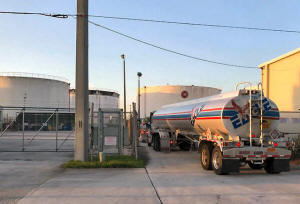|
Why consumers pay the price for hurricane
fuel shortages
 Send a link to a friend
Send a link to a friend
 [September 26, 2017]
By Devika Krishna Kumar and Libby George [September 26, 2017]
By Devika Krishna Kumar and Libby George
NEW YORK (Reuters) - Just days after
Hurricane Harvey smacked Texas and hobbled a quarter of U.S. refining
industry, the supply networks that fuel the nation's cars, trucks and
airplanes began to fail.
On paper, there was no fuel shortage. The United States had more than
200 million barrels of gasoline in giant steel tanks scattered across
the nation - enough to last more than three weeks.
But the fuel was unavailable to prevent shortages for two reasons: most
of it is not owned or managed by the government, sitting instead in
commercial facilities, and it is stored far away from where it was
needed.
Consumers paid the price as gasoline spiked ahead of Harvey's arrival
and jumped again after the storm as the extent of the disruption to
Texas refiners became apparent.
Prices surged even higher when Hurricane Irma hit Florida, which relies
on Gulf Coast supply.
That left Florida residents scrambling for fuel in one of the largest
evacuations in history. Thousands of stations closed, driving high
prices and long lines those remaining open. The supply chain breakdown
caused delays and expense at the worst possible time for families
fleeing the storm.

The shortages were felt nationally - with an average gas price spike of
10 percent - and internationally, as countries dependent on U.S. exports
had to find replacement supplies.
When Harvey shut pipelines and ports that transport millions of barrels
of fuel nationwide from the Gulf, it left major cities with only a few
days' supply of fuel.
Pipelines started closing five days after Harvey hit, with nothing to
pump through key fuel conduits from Texas to New York, Philadelphia and
Chicago.
"It proves to you how vulnerable the country is to the pipelines," said
Dennis Curtis who runs Curtis Oil, a fuel distributor in the Carolinas.
"When they go down, it's a ripple effect all the way to New Jersey."
The storm's disruption to domestic and global fuel supplies led the
International Energy Agency, the watchdog for energy security in
industrialized nations, to call for a review of the way the U.S.
government plans for emergencies.
A boom in U.S. fuel production has also made refineries here big
suppliers to Latin America and Europe.
"The rise of the Gulf Coast as a major energy hub means that ... normal
operations are too important to fail," the IEA said in a report earlier
this month.
UNSTRATEGIC STOCKS
Most of the 216 million barrels of gasoline in storage in the United
States is owned by refiners, traders and fuel distributors.

The stockpiles sit where holding them makes commercial sense to the
firms that own them - and not where it might best help consumers during
emergencies.
Oil firms try to limit storage to hold down costs, and the fuel that is
stored often sits at refineries because the firms already own the land
and the necessary permits.
That meant Harvey flooded many storage facilities when it hit Texas
refineries, cutting them off from the pipeline network.
Another oil stockpile - U.S. government-owned crude, held in the
Strategic Petroleum Reserve - is less useful for emergency supply
shortages because crude needs refining.
When the SPR was established in 1975, the government's biggest concern
was potential disruption of imports of Middle East crude, not post-storm
fuel shortages.
After Harvey, some refineries requested crude from the SPR, which
currently hold 675 million barrels. The Department of Energy (DOE)
granted exchanges of more than 5 million barrels to keep refineries that
were not flooded up and running, Energy Secretary Rick Perry said.
FACTBOX:
The DOE also temporarily waived the Jones Act, a century-old law that
limits coastal shipping of oil products to only U.S. flagged ships.
[to top of second column] |

A 10,000-gallon tanker truck goes into the fuel distribution area
post Hurricane Irma and Hurricane Harvey, at Port Everglades in Fort
Lauderdale, Florida, U.S. September 13, 2017. REUTERS/Bernie Woodall

TRUMP, CONGRESS AIM TO SELL STOCKPILES
The disruption that Hurricane Sandy caused New York and the
Northeast in 2012 led to the establishment of the country's only
government-owned fuel reserve.
But it holds only 1 million barrels - or about enough for one U.S.
rush hour morning - and is located in Massachusetts, New York and
Maine. None of the fuel was released during Harvey or Irma.
After Sandy, the Department of Energy (DoE) debated where else to
put reserves in the country and targeted the Southeast, which has no
refineries. But the administration decided against it because it
could not find affordable storage facilities to rent, said
Christopher Smith, a DOE assistant secretary under former president
Barack Obama.
Now, even the small Northeast stockpile may disappear: The Trump
administration in May proposed selling its gasoline to help balance
its proposed 2018 budget.
Trump's budget also proposed selling half of the crude in the SPR.
His plan has little support in Congress, but lawmakers have
previously approved selling smaller amounts from the SPR to raise
money for various other priorities.
The Department of Energy, which coordinates the government response
to shortages, did not respond to a request for comment about
gasoline supplies after the storms.
A SLOW MARKET RESPONSE
The lack of sufficient government fuel stockpiles leaves consumers
to the whims of global fuel markets after storms. And that can take
time.

When fuel prices spiked in shortage areas after the recent
hurricanes, cargoes of gasoline and jet fuel were shipped from
Europe and Asia to the United States. Fuel distributors trucked and
shipped gasoline and diesel in from other parts of the country to
areas of shortage.
But the interim period was tough on consumers - even those as far
from the storms as Chicago, where wholesale gasoline prices jumped
about 25 cents a gallon, or 10 percent. [PRO/U]
That's because fuel terminals stopped sales to some distributors
after the Explorer Pipeline shut on Aug. 29, just five days after
Harvey hit. The line pumps fuel from Texas to Chicago.
Chronister Oil Co in Illinois, which supplies a convenience store
and gas station chain in that state, had to reroute trucks to find
fuel after its regular terminals refused to sell it, he said.
"There were incredible amounts of fear and uncertainty," said Bryce
Rawers, Chronister's director of fuel supply.
Supply shortages hit consumers in other cities from Dallas to
Nashville and Atlanta.
The biggest pump price shocks after both storms came in the
southeastern states of Florida, Georgia, South Carolina and North
Carolina, according to U.S government data.
Those four states have no refineries and few pipelines.
The market "is capable of taking care of everyone," said Angela
Holland, president of the Georgia Association of Convenience Stores.
"Just not today."
(GRAPHIC - After storms, nationwide shortages despite oil in
storage: http://tmsnrt.rs/2y50FtJ)

(Additional reporting by Timothy Gardner in Washington; Editing by
Simon Webb and Brian Thevenot)
[© 2017 Thomson Reuters. All rights
reserved.]
Copyright 2017 Reuters. All rights reserved. This material may not be published,
broadcast, rewritten or redistributed. |